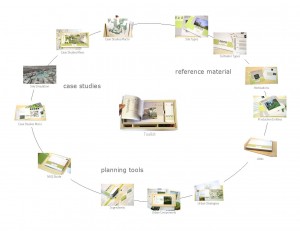The Food Urbanism Initiative (FUI) addresses three contemporary urban problems: the space inside a growing city, the well-being of its inhabitants, and the food which sustains them. First, the Swiss city needs to grow upon itself, resulting in more people occupying less space, with an associated risk of loss to the quality of space and life. Second, urban residents have become disconnected from the source and provenance of their food, with the associated risks of decrease in the quality of nutrition and health as well as social alienation between food growers and consumers. Finally, the existing cycle of food production-distribution- consumption is taking an increasingly higher environmental toll on the planet with a risk of depletion of natural resources. In addition, as urban food production has begun to occur inside the city, it risks to compete with other urban needs as well as with traditional farming.
Considering these issues, FUI aims to investigate how new urban quality can be attained by the thoughtful integration of food production into urban design and planning. To achieve this, FUI investigates the overall impact of urban agriculture on urban design and studies the potential of new agricultural, landscape and architectural strategies for food production, processing, distribution and consumption in the city. From this understanding, FUI develops design strategies and policies for future urban development that integrate both city life and food production cycles into a more harmonious coexistence, socially, economically, and environmentally responsible. The research specifically examines conditions within its case-study area of Lausanne.
FUI assesses the benefits, costs, risks and potential returns of different initiatives and their implications and opportunities for the urban population. By focussing on the cultivation of vegetables, fruits and berries, all suitable for small plots, while excluding larger livestock and « staple » crops, FUI identifies and describes the vast range of urban food production methods, motivations, producers as well as potential urban sites. In doing so, the research increases awareness among the urban population of the obstacles and benefits. Specific research objectives and results include the following;
– Identify and describe the processes of urban agriculture as they relate to urban design
– Codify an interdisciplinary language for urban agriculture and design (typologies)
– Establish connections between food production, urban design and urban quality
– Explore the possibility of spatial / functional combinations between food and urbanism
– Create transferable knowledge





